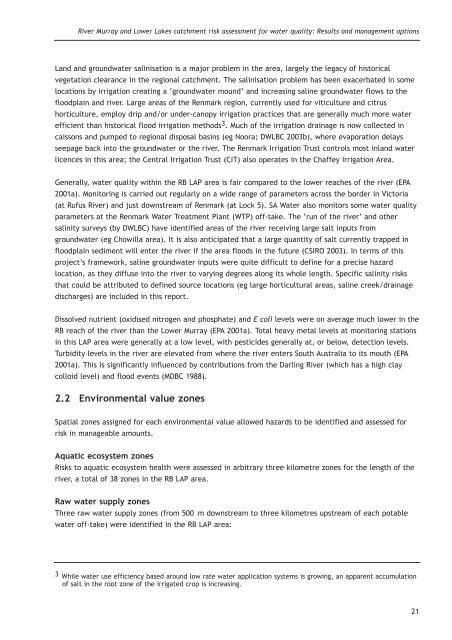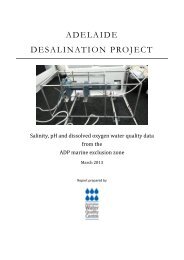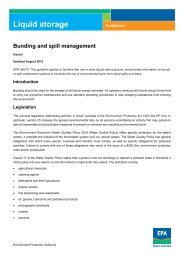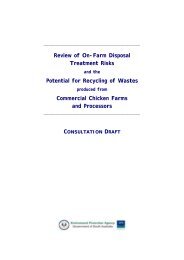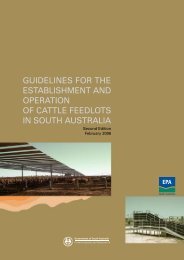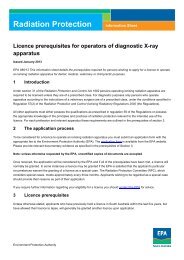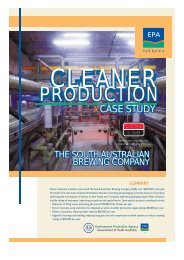2 Renmark to border LAP area assessment - EPA - Sa.gov.au
2 Renmark to border LAP area assessment - EPA - Sa.gov.au
2 Renmark to border LAP area assessment - EPA - Sa.gov.au
Create successful ePaper yourself
Turn your PDF publications into a flip-book with our unique Google optimized e-Paper software.
River Murray and Lower Lakes catchment risk <strong>assessment</strong> for water quality: Results and management options<br />
Land and groundwater salinisation is a major problem in the <strong>area</strong>, largely the legacy of his<strong>to</strong>rical<br />
vegetation clearance in the regional catchment. The salinisation problem has been exacerbated in some<br />
locations by irrigation creating a ‘groundwater mound’ and increasing saline groundwater flows <strong>to</strong> the<br />
floodplain and river. Large <strong>area</strong>s of the <strong>Renmark</strong> region, currently used for viticulture and citrus<br />
horticulture, employ drip and/or under-canopy irrigation practices that are generally much more water<br />
efficient than his<strong>to</strong>rical flood irrigation methods3 . Much of the irrigation drainage is now collected in<br />
caissons and pumped <strong>to</strong> regional disposal basins (eg Noora; DWLBC 2003b), where evaporation delays<br />
seepage back in<strong>to</strong> the groundwater or the river. The <strong>Renmark</strong> Irrigation Trust controls most inland water<br />
licences in this <strong>area</strong>; the Central Irrigation Trust (CIT) also operates in the Chaffey Irrigation Area.<br />
Generally, water quality within the RB <strong>LAP</strong> <strong>area</strong> is fair compared <strong>to</strong> the lower reaches of the river (<strong>EPA</strong><br />
2001a). Moni<strong>to</strong>ring is carried out regularly on a wide range of parameters across the <strong>border</strong> in Vic<strong>to</strong>ria<br />
(at Rufus River) and just downstream of <strong>Renmark</strong> (at Lock 5). SA Water also moni<strong>to</strong>rs some water quality<br />
parameters at the <strong>Renmark</strong> Water Treatment Plant (WTP) off-take. The ‘run of the river’ and other<br />
salinity surveys (by DWLBC) have identified <strong>area</strong>s of the river receiving large salt inputs from<br />
groundwater (eg Chowilla <strong>area</strong>). It is also anticipated that a large quantity of salt currently trapped in<br />
floodplain sediment will enter the river if the <strong>area</strong> floods in the future (CSIRO 2003). In terms of this<br />
project’s framework, saline groundwater inputs were quite difficult <strong>to</strong> define for a precise hazard<br />
location, as they diffuse in<strong>to</strong> the river <strong>to</strong> varying degrees along its whole length. Specific salinity risks<br />
that could be attributed <strong>to</strong> defined source locations (eg large horticultural <strong>area</strong>s, saline creek/drainage<br />
discharges) are included in this report.<br />
Dissolved nutrient (oxidised nitrogen and phosphate) and E coli levels were on average much lower in the<br />
RB reach of the river than the Lower Murray (<strong>EPA</strong> 2001a). Total heavy metal levels at moni<strong>to</strong>ring stations<br />
in this <strong>LAP</strong> <strong>area</strong> were generally at a low level, with pesticides generally at, or below, detection levels.<br />
Turbidity levels in the river are elevated from where the river enters South Australia <strong>to</strong> its mouth (<strong>EPA</strong><br />
2001a). This is significantly influenced by contributions from the Darling River (which has a high clay<br />
colloid level) and flood events (MDBC 1988).<br />
2.2 Environmental value zones<br />
Spatial zones assigned for each environmental value allowed hazards <strong>to</strong> be identified and assessed for<br />
risk in manageable amounts.<br />
Aquatic ecosystem zones<br />
Risks <strong>to</strong> aquatic ecosystem health were assessed in arbitrary three kilometre zones for the length of the<br />
river, a <strong>to</strong>tal of 38 zones in the RB <strong>LAP</strong> <strong>area</strong>.<br />
Raw water supply zones<br />
Three raw water supply zones (from 500 m downstream <strong>to</strong> three kilometres upstream of each potable<br />
water off-take) were identified in the RB <strong>LAP</strong> <strong>area</strong>:<br />
3 While water use efficiency based around low rate water application systems is growing, an apparent accumulation<br />
of salt in the root zone of the irrigated crop is increasing.<br />
21


